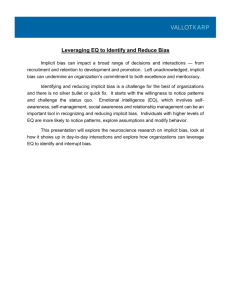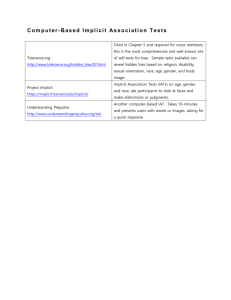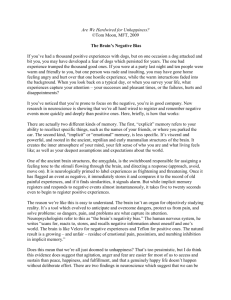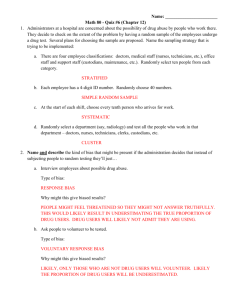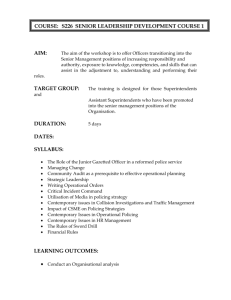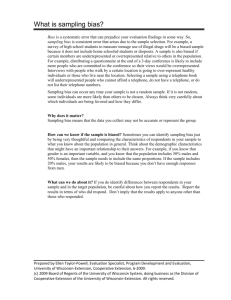Prompt Slide - Fair & Impartial Policing
advertisement
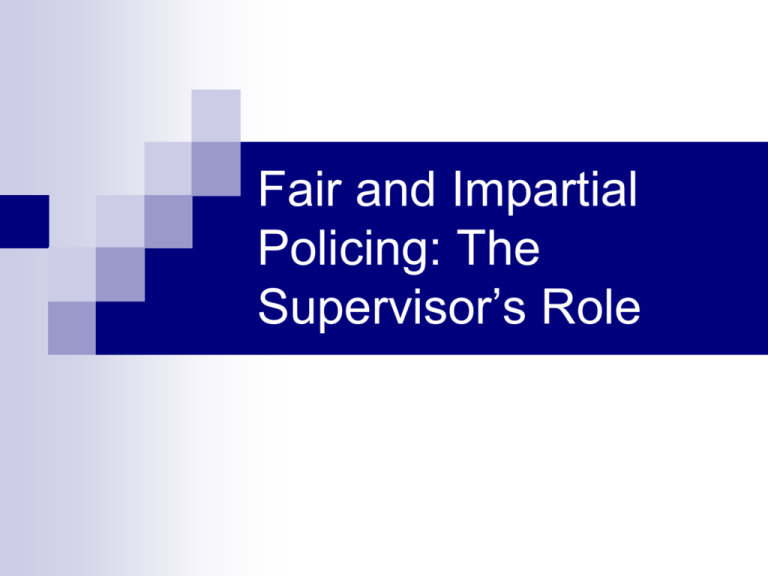
Fair and Impartial Policing: The Supervisor’s Role Introduce yourself Your experience Share something about yourself Goals of this Training Understand that all people, even wellintentioned people, have biases Understand how implicit biases can affect perceptions and behavior Understand how biased policing impacts community members and the law enforcement organization Goals of this Training--2 Understand the role of supervisors, as leaders, in implementing organizational change that leads to fair and impartial policing Understand how to address biased behavior with individual officers, community members and the public. Supervisors/Leaders Have a Responsibility to Ensure that Officers: Are effective at solving crimes and handling problems Stay safe and go home at the end of the shift Enhance/promote trust with the community they serve. Effective Supervisors/Leaders Are: Role Models Mentors Representatives of the Department Authorities on Policy and Practice Professional Coaches Disciplinarians Change Agents During this Training Relax: Leave your preconceived notions about “bias” training at the door. Our approach is different from traditional training. During this Training Reflect: Think about what it means to be an effective supervisor. …what you expect of yourself and your officers. During this Training Recognize You your expertise. bring experience and expertise to the discussions. During this Training Stretch your imagination and apply your skills. This training requires active participation in all of the discussions and exercises. Understanding Human Bias Susan Boyle – Britain’s Got Talent Fundamental Concepts of Human Bias Bias is a normal human attribute—even wellintentioned people have biases Biases are often unconscious or “implicit” Implicit biases are sometimes incompatible with our chosen beliefs and values Implicit biases can influence our actions Understanding how implicit bias can affect our behavior is the first step to “overriding” implicit bias Understanding Implicit Bias Whom we are most likely to pre-judge What determines the characteristics we assign to them Whether we know when we are prejudging people Understanding Implicit Bias-Answers Whom do we pre judge? We prejudge “ambiguous stimuli” What determines the characteristics we attribute to them? Group stereotypes/biases Do we know when we are doing this? Not always. Bases on which People may be Stereotyped (and Treated Differentially) Income English language abilities Gender Age Religious affiliation Profession Sexual orientation, identity etc. Prompt Slide: Woman/Man with a Gun Role Play We implement in the recruit training Key point of role play… Key Point of Role Play Policing based on stereotypes is unsafe. Key Points of the “Blink” Response Recognize the “blink” response Replace it with objective (bias free) judgments Prompt Slide: Key Points of the “Blink” Response Recognize the “blink” response” Replace it with objective (bias free) jugdements “Money Train” Woody Harrelson is an undercover officer. Note: The use of the copyrighted material falls under fair use laws with no intended copyright violation. Credits: Stereotyping and Human Bias When we don’t know an individual, we assign a group characteristic to them Often we do not know when we are impacted by biases (they can be unconscious or “implicit” biases) Recognizing our biases allows us to override them—to engage in unbiased behavior. Prompt Slide: Law Enforcement and Community Law enforcement officers deal with a variety of community members…… Mad World Video – Gary Jules Prompt Slide: Susan Fiske Implications Fiske How do people in our society react to the homeless? How might some officers treat the homeless versus person of means? Key Point: Policing based on stereotypes is unjust. Race-Crime Association Studies Fill in ambiguous stimuli Don’t know it Now: Race-Crime subset of implicit biases The “Shove” Study Study: Subjects observed two individuals in video. Disagreement and shove. Did the subjects interpret the shove by African Americans differently than shoves by Whites? How? Result: The “shove” was perceived as more threatening when performed by an African American (Duncan, 1976). Replicated and showed this was true for both White and non-White subjects (Sager and Schofield, 1980). The Visual Perception Study Subjects were primed with Black male faces, White male faces, or no faces Completed object recognition task (Eberhardt, Goff, Purdie, & Davies, 2004). Levels of Degradation Frame25 141 Frame Crime Relevant Object Crime Relevant Object Crime Neutral/Irrelevant Object Hypotheses If the Black-crime association impacts our visual perception, then: Participants primed with Black male faces should be faster to identify crime-relevant objects than those primed with White male faces. There should be no effect of prime for crimeirrelevant objects. Object Identification ________________________________ 28 Crime-Relevant Frame number 26 Crime-Irrelevant 24 22 20 18 16 Flashing White Faces No Faces (Control) Flashing Black Faces Visual Perception Study: Conclusions Exposure to Black male faces facilitated the identification of crime-relevant objects. Exposure to White male faces inhibited the identification of crime-relevant objects. Be a Research Participant! We will see slides of backgrounds and then a person will appear—very quickly— with something in his hands. Shout “Threat” if you see a threat [Silent if no threat] Correll Results: Race Made a Difference Speed: Participants shot a White armed man slower than a Black armed man. Errors: Participants were more likely to shoot an unarmed Black man than an unarmed White man. (Correll, 2002) The Turban Effect Study Research volunteers played a computer game that showed apartment balconies on which different people appeared, some wearing Muslim-style turbans and others bare-headed. They were told to shoot at the people carrying guns and spare those who were unarmed. The Turban Effect Results People were much more likely to shoot Muslimlooking characters even if they were carrying an “innocent item” instead of a weapon. They also found a gender effect: Subjects were more likely to shoot men than women even when both appeared harmless. (Unkelbach, Forgas & Denson, 2008) Prompt Slide: Implications for Law Enforcement Officers may see danger when none there (over-vigilant) May overlook danger (under-vigilant) (Money Train example) Due to Implicit Bias, Officers May: Increase scrutiny of people of color Interpret ambiguous behavior on the part of people of color as more aggressive Respond to people of color more aggressively Under-respond to Whites, Asians, etc. And so forth. Biases are Based, at Least in Part, on Fact (Example) Prompt Slide: One example pertains to race and crime Criminologists have shown that people of color are disproportionately involved in street crimes Economic Status, Race and Crime A = Lower income people are disproportionately represented among people who commit street crimes B = People of color are disproportionately represented in lower income levels A+B=C People of color are disproportionately represented among people who commit street crimes… Prompt Slide: But, that stereotypes are sometimes based in part on fact…. Does not justify your making policing decisions based on those stereotypes. Such decisions can be unsafe, ineffective or unjust. Crash Scene: The Streets of Los Angeles Usage of the copyrighted material falls under fair use laws with no intended copyright violation. Sandra’s character was right! Her stereotype held true. Sometimes your “blink response” is right. But sometimes it is wrong. It is unreliable. Because it is unreliable, you should not police based on your blink responses, your biases…. Key Point Policing based on biases is unsafe, ineffective, and unjust… As First-Line Supervisors You Help Your Officers To: Effectively perform their duties and solve crimes Identify the right suspect and make good cases Keep safe and go home at the end of the day Policing based on biases/stereotypes impedes achievement of these objectives! Implicit Bias Manifests in NonPrejudiced People Prompt Slide: Implicit Biases Implicit bias manifests even in nonprejudiced people Exists even in individuals who consciously hold non-prejudice ideals/attitudes EX: Even many minorities have a racecrime/danger implicit bias (Shove Study)…. Prompt Slide: Some Think…. Biased policing is “someone else’s issue” Often think that because of their progressive attitudes towards other groups, they must be bias free Quite likely: They are wrong. Addressing Our Implicit Biases Prompt Slide: Two remedies for our implicit bias “affliction” #1. Reducing our implicit biases #2. Recognizing our biases and thwart their impact on behavior. Prompt Slide: #1. Reducing implicit bias (A) Contact theory (B) Unlinking stereotypes Contact Theory: Reducing Implicit Bias Positive contact between members of groups improves inter-group attitudes and reduces both explicit and implicit biases. Prompt Slide: Biases Against.. Muslims are weaker in people who have had positive personal contacts with Muslims Native Americans …. Gays/Lesbians…. Poor people... Personal Contacts and Implicit Biases in Officers Peruche and Plant (2006) Measured implicit bias on the part of officers Shoot/don’t shoot simulator to measure implicit bias. Police, too, manifest implicit racial bias But implicit racial/ethnic bias is weaker in officers who report positive interpersonal contacts with racial/ethnic minorities Prompt Slide: Key Point Very normal human interactions can help us reduce our biases. Prompt Slide: Unlinking Stereotypes Difficult to undo our implicit biases….took lifetime BUT police firearms training seems to help us unlink the stereotypes we associate with groups (e.g., minorities and danger) How might this work? Repeatedly exposed to random pairing of threat and race (and other demographics). Unlinking Stereotypes: Correll Study #2 Speed: Both police and civilians exhibited robust racial bias Errors: Bias was less likely to manifest itself in the decisions by police (Correll, 2007). Bottom Line: Police made the correct decisions. Implication: High quality, role play use-of-force training helps police “unlink” race & crime for split-second use-of-force decisions. Prompt Slide: Remedy #1: Reduce implicit biases Remedy #2: Recognize our biases and thwart their impact Implementing “Controlled (unbiased) Behavior” If we recognize our biases We can implement “controlled behaviors” that override our (natural) implicit biases. (Prof example) Summary: Fundamental Concepts of Human Bias Bias is a normal human attribute—even wellintentioned people have biases Biases are often unconscious or “implicit” Implicit biases are sometimes incompatible with our chosen beliefs and values Implicit biases can influence our actions Understanding how implicit bias can affect our behavior is the first step to “override” implicit bias The Impact of Biased Policing on Community Members and the Department MODULE 2 Prompt Slide : Previous Module Science of implicit bias – perceptions and behaviors Forms of implicit bias with policing relevance (including race-crime) Biased policing is ineffective, unsafe and unjust Biased Actions Impact: Community members Your law enforcement agency Prompt Slide: Impact of Biased Policing on Individuals Testimonial: Captain Will Hill RI State Police FAIR AND IMPARTIAL POLICING ENGENDERS COMMUNITY RESPECT AND COOPERATION Prompt Slide: How does your agency benefit when the community trusts and respects you? Research Demonstrates Police cannot be effective without support/cooperation of the community Community members who perceive the police as being fair see them as a legitimate authority Supervisor’s Role in Engendering Police Legitimacy Prompt Slide: Your Daily Interactions Can influence community support of the department cops think – no one sees/cares YOUR actions determine whether the community thinks the agency is legitimate Some One aspect: Ensuring your actions are fair and impartial AND ensuring that the community SEES/PERCEIVES fair and impartial policing Police Legitimacy Impacts the Public’s Willingness To: Obey societal laws Cooperate with the police Assist with crime prevention efforts Assist with valuable information during criminal investigations Support criminal prosecutions Fair and Impartial Policing Results In…. Community trust and cooperation Legitimacy of police among community members Safe policing Effective policing “Good” policing Supervising for Fair, Impartial, and Effective Policing MODULE 3 Prompt Slide: In the beginning of this training session… We made the point that supervisors are… One of your most challenging tasks is to guide your officers . . . The decisions you make and the actions you take . . . In This Session How to identify bias in your direct reports How to intervene when you suspect bias How to assess your own potential for biased decisions How to speak to individuals, community forums and media about bias and biased policing Prompt Slide: The Power of Supervisors Let’s talk about the power of the supervisor.. Supervisors should convey the importance of fair and impartial policing… If fair and impartial policing is important to you as a supervisor. . . “Crash” Prompt Slide: Think About… What should the Lieutenant have done? The message the Lieutenant sent. The culture of a department that would support/condone such a response. Identifying Biased Policing in Your Direct Reports Prompt Slide: Recall, bias can manifest in ill-intentioned OR in well-meaning officers Your job: Identifying when bias manifests in either Question: “What should I be looking for? Prompt Slide: Picture an Officer who…. “Sees crime” in young Latino males: What types of actions on the part of this officer might be impacted by this bias? That is, what might this person do more (or do less) with Latinos? Prompt Slide: Picture an Officer who… “Sees” well-to-do as law abiding, honest How might this officer treat a wealthy person compared to a poor person? YOUR JOB: Be on the look out. Prompt Slide: What are your sources of information for detecting biased behavior? On-sight observations Written reports Radio/MDT transmissions Citizen/Internal complaints Evaluations Information provided by other officers Early Intervention System (albeit, limited)… SC Law on Data Collection Article 48, Chapter 5, Title 56 Requires the collection of data on motor vehicle stops that do not result in a citation or arrest Information collected: Age, gender, race/ethnicity of driver Agencies who comply are eligible for highway safety funds Data are not yet linked to individual officers. Prompt Slide: Identifying biased behavior in direct reports Again: Several sources of information For original detection For affirming/allaying concerns Again: Looking for biased behavior on the part of: Ill-intentioned Well-intentioned But acknowledge this is very difficult… Prompt Slide: It is difficult to identify bias! Not visible behavior like force, it’s what the officer is thinking This is why we can’t rely on department’s complaint system But this doesn’t mean we “throw up our hands”..... Must understand and deal with less than clear information and evidence. Intervening to Thwart Biased Behavior Prompt Slide: We have discussed how biased behavior can manifest in your direct reports and the types of information you might use to identify behaviors of concern. Prompt Slide: Officer Gary Sees crime pretty much in all young Latino males. Uses traffic stops to pull Latino males over to visually check interiors of cars. Much more aggressive with these folks. No specific crime reports targeting Latino males. Good cop otherwise; number of commendations for his kindness and beyond-the-call-of-duty activities. As a supervisor, what do you do about this officer? Addressing Bias with Direct Reports Recognize ambiguous nature of the “evidence” of biased behavior Approach: Share your observations Ask why this might be occurring Use non-accusatory tone Structure concerns in terms of officer safety and effectiveness Discuss how/why behavior might be biased and unacceptable Prompt Slide: Roll Call as a Teaching Opportunity Prevention is a great intervener. Look for regular opportunities to integrate Fair and Impartial Policing teachings. Prompt Slide: Role Call--2 Discussions about suspicions of biased policing will be easier if the discussion has occurred before in relaxed group settings. As a supervisor, periodically present hypothetical situations during briefing and discuss them calling upon the key points in this training. Supervisors are Human Too! Not just your direct reports who might have biases. Be aware that your decisions may be influenced by your own biases…. What decisions/actions on the part of a supervisor might be impacted by his or her biases (based on race, gender, etc.)? [Think of both decisions reflecting operational decisions and decisions associated with managing direct reports.] Prompt: Decisions/Actions that might be impacted Managerial examples: Deciding who gets assigned to do what Differential respectful treatment of direct reports Etc. Operational examples: What crimes on which to focus Where to allow aggressive treatment Etc. Prompt Slide: Your Directions.. Also: Be aware that some directions that you give could: Be interpreted through the biases of your officers Produce biased policing. Example. Departmental Policies Just discussed how to identify and respond to biased behavior Will soon have you discuss some situations that require problem solving. Relevant to that problem solving….. department policies. Prompt Slide: Department Policies Policies define biased policing Tells officers………can/can’t Many focus just on race/ethnicity, some broader There is not ONE definition of biased policing You need to know/understand policy to supervise to promote FIP Small Group Discussion Question (Focusing on race/ethnicity) When is it appropriate for police to take race/ethnicity into consideration when making law enforcement decisions (e.g., decisions to stop, arrest, request consent to search)? The Suspect-Specific Policy Model Officers may not consider the race or ethnicity of a person in the course of any law enforcement action unless the officer is seeking to detain, apprehend, or otherwise be on the lookout for a specific suspect sought in connection with a specific crime who has been identified or described in part by race or ethnicity. The PERF Policy Model Officers shall not consider race/ethnicity [or other demographics listed here] in carrying out law enforcement activities except when credible, locally relevant information links a person or people of a specific race/ethnicity [or other] to an unlawful incident, unlawful incidents, criminal patterns, or schemes. Prompt Slide: Again: Policy Importance In supervising to promote fair and impartial policing Agency policy defines what it is. This is relevant to next exercises….. Scenarios 1 - 7 Talking with the Community and the Media about Bias Prompt Slide: Talking with community, individuals For example: Citizen concerns of bias, community meetings, media Palo Alto Have you had to deal with an individual or group with concerns about bias? What did you do? Were you good? Bad? What would you do differently? Prompt Slide: Individual community member ….. Alleging biased behavior Can be tense Let’s start with this: How do you want your subordinates to respond to accusations of biased behavior made against them in a situation like this? … (Geico Commercial) A Suggested Response to an Accusation of Biased Behavior “I am sorry that you feel that way. I stopped you [or whatever the officer did to intervene with the community member] because you _____ [officer explains the violation or other reason for the intervention].” Prompt Slide: Why this language? Officer’s denial will not be effective Won’t change motorist’s mind And besides: The motorist might be right!! (What have we learned?) Our suggested language: Acknowledge Back to business. Prompt Slide: Now you are called to the scene What do you do/say? What do you not do/say? What To Do Listen to the concerns of community members Inform community members of their right to file a complaint and the process for doing so What NOT To Do Adjudicate on the spot Prompt Slide: Speaking to community groups about bias BEFORE the crisis Do your agencies hold community meetings? Use these to talk about bias More constructive “before the storm” Fair and Impartial Policing Messages Fairness and impartiality are the values of the agency Agency does not tolerate biased policing We understand, however, that humans have biases and so… The agency has instituted policies and procedures to promote fair and impartial policing, including… Prompt Slide: Speaking to an angry community AFTER an incident (where bias is alleged) Objectives of Communication: Reduce Relay anger, tension factual information about the incident Prompt Slide: Sure-fire way to increase tension and anger Declare: “No biased policing occurs in this agency.” The Crisis Communication Message The agency does not tolerate biased policing; and has adopted policies, practices and training to promote fair and impartial policing. The agency is committed to conducting a comprehensive and transparent investigation Crisis Communication—2 The agency will listen to the individuals involved—both the subjects and the police–to understand fully the perspectives and facts. (Identify the specific steps in the investigation process). Crisis Communication–3 The agency will listen to community members to understand your frustration and anger. The agency will openly communicate the findings and results of the investigation. The Media Message Use the crisis communication Describe what the agency is doing to promote fair and impartial policing Prompt Slide They may run the “bias” story… BUT, they may also write about your agency’s science-based approach to FIP Leadership and Organizational Change: Promoting Fair and Impartial Policing To Promote FIP, Your Organization Might…. Create or revise policies addressing the use of race and ethnicity (and other demographics) in law enforcement decisions and actions Promote and facilitate the identification of biased behavior on the part of your officers Revise/expand training and education about bias within the organization and perhaps the community Your Organization Might… Strengthen the way you communicate your organization’s values and respond to allegations of bias from community members. Help personnel to speak effectively and comfortably about bias when interacting with individual officers, community members and the general public. Leading Change is Challenging… In ALL organizations In law enforcement organizations, which: Are steeped in tradition Are highly bureaucratic Have hierarchical command, control and communications structure Leading Change: The Basics A large body of literature—both academic and popular John Kotter, Harvard Business School Leading Change (1996) — 8 Steps Kotter’s 8 Steps to Leading Change Create Urgency Form a Powerful Coalition Create a Vision for Change Communicate the Vision Remove Obstacles Create Short-Term Wins Build on Change Anchor FIP in Organizational Culture Step 1: Create Urgency Conduct open and honest dialogue about the bias allegations by engaging community and law enforcement leaders and officers Describe to your direct reports what would happen if you did nothing Present why “now” is the right time to act. Step 2: Form a Powerful Coalition Key leaders from community and law enforcement Lends credibility to change efforts Holds agency accountable Continues to build urgency and momentum around the need for change Step 3: Create a Vision for Change Primary responsibility of the Chief executive Supervisors are key to: ensuring that the vision is supported within the organization and implementing specific actions/steps to operationalize the change efforts. What the Vision for Change Should Do Articulate how the vision for change reflects the values of the organization Outlines the roles of supervisors and other members of the organization in implementing the change Identifies the organizational systems/processes to promote FIP Step 4: Communicate the Vision Communicate at EVERY opportunity FIP = the values of the organization What specifically the organization is doing to institutionalize FIP Address concerns of peers and direct reports Lead by example: Model the behavior you expect Step 5: Remove Obstacles Identify resistors Help them see what’s needed and why Help them see benefits of change Recognize and reward commitment to FIP Step 6: Create Short-Term Wins Identify short-term wins What do you want to see or hear about FIP? Step 7: Build on Change Analyze what is going right and what needs improving Set goals to continue building on the momentum you've achieved Keep ideas fresh—expand internal and community supporters/coalition Don’t be “Mission Accomplished!” Step 8: Anchor FIP in the Organizational Culture Supervisor Role: Model FIP Communicate commitment to FIP Coach/mentor direct reports Publicly recognize fair and impartial policing behavior Talk about progress Leadership Defined The process of influencing the behavior of others… To achieve organizational goals.. While developing high performing individuals, teams, and the organization for future service Leadership is Influencing.. Individuals Organizations Groups Leadership Styles The Transactional Leader The Transformational Leader The Transactional Leader Uses rewards and punishments Clarifies roles and responsibilities Subordinates’ self-interests are enhanced when they behave appropriately Fair and impartial behavior leads to safe, effective and just policing The Transformational Leader Inspires subordinates to be fair and impartial by emphasizing the importance of it Gets subordinates to “transcend” their own self interests for the sake of the team, organization, community Summary of Key Points All people, even well-intentioned people have biases They can be “implicit” (unconscious) Policing based on biases can be unsafe, ineffective and unjust Summary of Key Points-2 Biased policing has negative consequences for community members and the department Biased policing erodes community trust Community trust is essential for cooperation and support of officers and the department Community trust is essential for police legitimacy Supervisors’ Responsibilities Be role models, mentors, representatives of the department, authorities on departmental policy, and disciplinarians Identify possible manifestations of bias Prevent biased behavior and intervene when indicated Discuss biased policing with subordinates and community Supervisors are Human Too! Your decisions may be impacted by human biases Your biases may impact your treatment of direct reports Your biases may impact your policing decisions Leadership and Change Management Leading change to promote FIP is challenging Apply the 8 steps of leading change to implement a comprehensive approach to promote FIP Understanding leadership styles can benefit FIP change efforts We hope this training… Better understanding science of human bias Renewed your appreciation of negative impact You learned skills ….will serve you In your role as effective supervisor … Will help you supervise to promote FIP Thank you!! THANK YOU!
